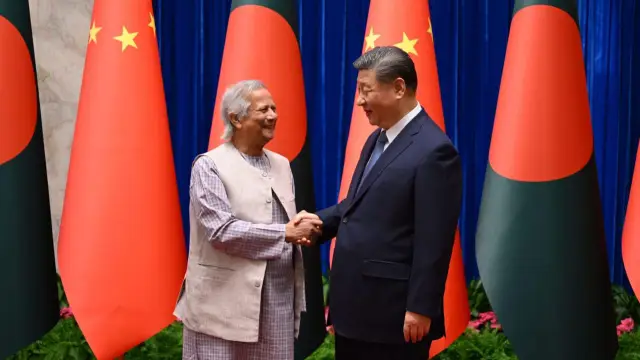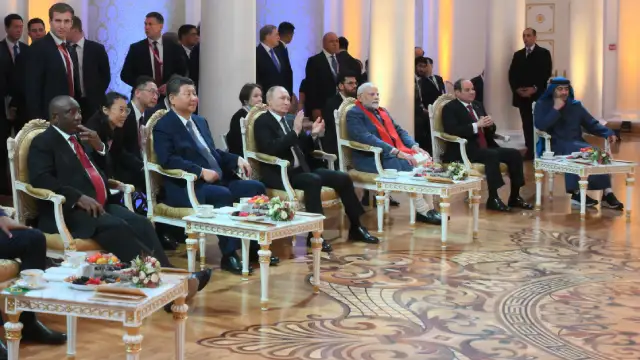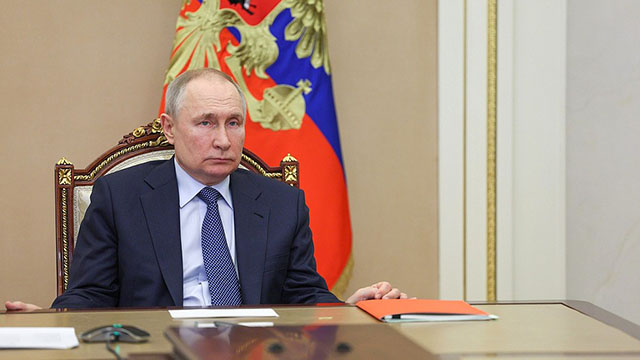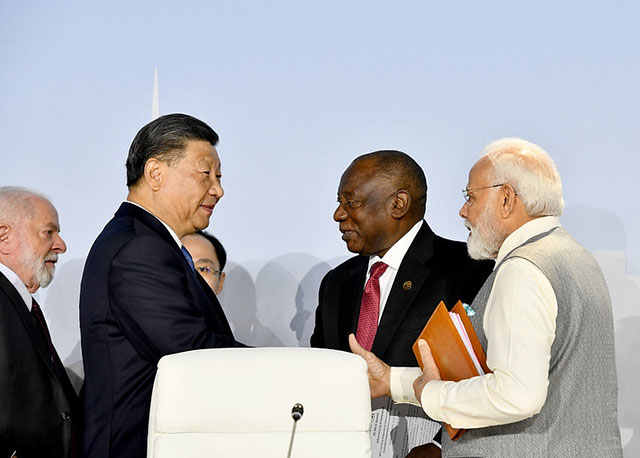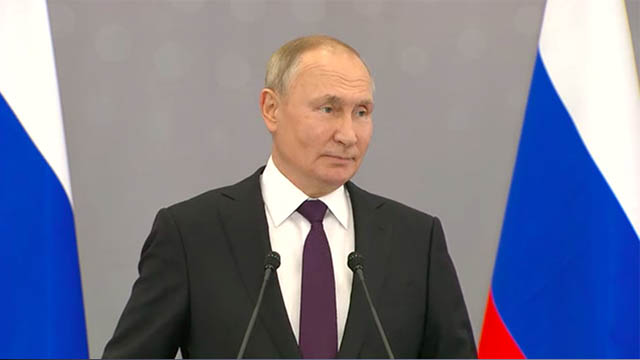On October 30th, Donald Trump met Xi Jinping in South Korea’s Busan to reset ties with China. The US president emerged with extravagant praise, rating their encounter “12 out of ten”. What he did not fully articulate was the inversion of geopolitical logic that underpins the encounter. Mr Trump slashed tariffs on Chinese goods from 57% to 47%. In exchange, China agreed to buy US agricultural products, mainly soybeans, and maintain rare earth mineral exports. However, the next day, Defence Minister Rajnath Singh signed a 10-year India-US defence pact. This pact aimed squarely at countering Beijing’s regional assertiveness. This sequence of events highlights a very strange geopolitical gambit in what’s called the Indo-Pacific war theatre.
The timing exposes a central contradiction in India-US relations with China. New Delhi and Washington proclaim their shared purpose—constraining Beijing’s influence across the Indo-Pacific. Yet both nations remain economically shackled to the very power they claim to oppose.
India cannot secure critical minerals without Chinese permission. The US cannot reduce its dependence on Chinese rare earths despite years of rhetorical commitment to “friendshoring”.
The India-US defence pact, signed on October 31st, rests on the foundations of sand. The sands can shift quickly.
It ignores the economic reality that makes containment impossible. India and the US have constructed a military edifice while their economies remain hostage to Beijing’s goodwill.
This is the story of how strategic competition becomes performance theatre.
Busan bargain: Trump’s comfortable compromise
The meeting between Mr Trump and Mr Xi represents something far simpler than the US president’s hyperbole suggested. It’s a pause. Not peace. Not a resolution. A temporary agreement to reduce the temperature of a trade conflict that neither side wishes to escalate further.
The economic data tells a revealing story. Chinese exports to the United States rose from $28.8bn in May 2025 to $34.3bn in September. US economic pressure, despite the aggressive rhetoric, had failed to deter Beijing’s sales.
Mr Trump understands this reality. His decision to reduce tariffs reflects not US strength but the limitations of tariff warfare against an economy so deeply woven into global supply chains.
China agrees to purchase US soybeans and sorghum. Beijing also promised to maintain rare earth mineral flows to world markets. The agreement includes a vague commitment to discuss ending fentanyl precursor trafficking. On these narrow terms, both sides claimed victory.
Yet the architecture of the deal reveals deeper truths about the relationship—the agreement lasts only one year! It appears like a geopolitical trial pack.
Both sides reserve the right to renegotiate annually. This is not how permanent trade frameworks operate. Standard World Trade Organisation deals provide long-term certainty. This arrangement signals profound mutual distrust. It suggests both nations believe the other side will abandon the agreement at any convenient moment.
Mr Trump’s enthusiasm masks an uncomfortable reality—he has secured a temporary ceasefire, not a strategic advantage.
The US president needs to demonstrate dealmaking prowess to domestic audiences.
Mr Xi requires stability ahead of China’s economic challenges.
The meeting satisfied both leaders’ immediate political needs. It solved nothing of substance.
The rare earth agreement particularly merits scrutiny. China controls approximately 70% of global rare earth supplies. Beijing dominates 90% of global processing capacity.
This monopoly exists not by accident. Over three decades, China has been systematically investing in rare earth mining and processing infrastructure.
Meanwhile, the US outsourced its own rare earth processing to China. US policymakers prioritised carbon footprint reduction and cheap labour over strategic autonomy. Now they find themselves dependent on the very nation they claim to contain.
Double standard: Selective outrage over Russian oil
Here lies perhaps the most brazen contradiction in contemporary US foreign policy.
India faces a 25% tariff penalty for importing Russian oil.
Mr Trump’s administration imposed this surcharge in recent months. Trump’s trade adviser, Peter Navarro, called Indian purchases “blood money”. He alleges that New Delhi has dramatically increased Russian oil imports since the Ukraine invasion.
Trading with Russia makes you complicit in war crimes; this has been Washington’s message to New Delhi.
It has been a shock for Prime Minister Narendra Modi, who calls Mr Trump his friend.
However, when Mr Trump met Mr Xi, he negotiated tariff reductions.
Mr Trump himself acknowledged that China “has been buying oil from Russia for a long time”. He did not dispute China’s status as the world’s largest purchaser of Russian oil. China’s dependence on Russian energy markets exceeded India’s by substantial margins.
Yet Mr Trump announced plans for large-scale US energy sales to Beijing. He discussed potential oil and gas transactions from Alaska with Chinese counterparts. The US president gave the world’s largest Russian oil buyer tariff relief.
Mr Modi’s government has been subtly protesting the penal tariffs. New Delhi points out that China purchases more Russian oil than India, yet faces no penalty.
External Affairs Minister S Jaishankar had earlier noted that the European Union traded far more extensively with Russia than India. Yet Europe faces no tariff surcharges.
The US response has been silent. India would “continue to pay massive tariffs” if it refused to abandon Russian oil, Mr Trump stated. There has been no equivalent warning directed toward Beijing.
This asymmetry reveals the true architecture of US trade policy under Mr Trump. Strategic considerations matter less than negotiating leverage.
China possesses leverage through rare earth monopolies. China controls supply chains that US corporations depend upon. China could cause economic pain through tariff retaliation.
In contrast, India possesses no such leverage. India has been, therefore, vulnerable to tariff pressure.
Mr Modi’s government, facing domestic embarrassment in the election year, has been continuously negotiating with the US administration, but to no avail.
Mr Trump knows India could be punished without economic consequences to US interests.
Security mirage: India-US defence pact built on quicksand
The optics were carefully constructed when Mr Singh and his US counterpart Pete Hegseth signed the new Indo-US defence partnership framework on Friday.
Mr Singh declared it “a signal of our growing strategic convergence”. Mr Hegseth called it a “cornerstone for regional stability and deterrence”.
The India-US defence pact promises to deepen military cooperation across multiple domains. It references existing agreements, including the Logistics Exchange Memorandum, the Communications Compatibility and Security Agreement, and various liaison officer arrangements.
The document makes an impressive reading.
It promises enhanced coordination and information sharing. The India-US defence pact commits both nations to technological cooperation. It has been built upon years of defence procurements and military exercises. Yet the India-US defence pact has been inked at precisely the moment when the broader bilateral relationship faces its most severe strain.
India now faces 50% tariffs from the US. This has been the highest rate applied to any country globally. India’s exports to the US have collapsed by 37% between May and September 2025. Indian businesses watch their US market access vanish. Trade negotiations remain bogged down over the Russian oil penalty and other unresolved issues.
The defence partnership thus emerges as something peculiar—a statement of military intent divorced from economic reality.
Mr Singh and Mr Hegseth spoke of regional stability while Washington simultaneously destabilises India’s trade position through tariff warfare. The US promotes itself as India’s defence partner while imposing punitive economic measures.
The framework can’t resolve these contradictions. A decade-long military commitment is supposed to anchor the relationship against these economic storms. Instead, the defence pact appears as an instrument of political theatre.
Rare earth reality: India’s silent supplication to Beijing
In late October 2025, India’s Ministry of External Affairs acknowledged an uncomfortable truth. Some Indian companies had received Chinese export licences for rare earth magnets.
Four firms, including Hitachi and Continental India, had secured permits to import these critical materials from Beijing.
These were the first licences issued since China imposed tight export controls in April 2025.
The permissions came with conditions and restrictions.
Industry sources indicated that not all applications succeeded. Yet the fundamental reality remained stark: Indian industry depends on Chinese goodwill for essential inputs.
Why does this matter?
Rare earth magnets, particularly neodymium-iron-boron formulations, drive electric vehicles.
They power the motors that propel EVs forward. They enable power steering systems and braking mechanisms.
As India’s automotive sector races to electrify, these magnets become non-negotiable.
China maintains absolute dominance over rare earth magnet production.
The April 2025 export controls had alarmed Indian manufacturers. EV makers faced potential shortages. Production delays threatened. Price surges loomed. The Chinese licences, even limited ones, offered relief.
But before the relaxation came India’s U-turn on China. In August, Mr Modi made his first trip to China after the 2020 border clash in Galwan. This was preceded by a Russia-brokered ice-breaking initiative during the October 2024 BRICS summit, where the duo had their first bilateral meeting.
Though Mr Modi is keen to have India hooked to the US-led collective West’s bandwagon, economic realities have made his government realise that without China, India can’t navigate in the complex landscape of evolving technologies.
India’s predicament reflects deeper structural realities.
The nation has identified 30 critical minerals essential for development.
Every single one requires imports. India controls no meaningful domestic supplies of rare earths or critical minerals. Processing capacity is virtually non-existent.
The government auctioned 20 blocks for private sector mineral exploration. The response was poor. Deposits of most critical minerals are too small to justify commercial extraction unless bundled with larger mineral deposits nearby.
India’s 2025 national critical minerals mission remains in infancy. Experts estimate a gestation period of 15 years or more before India achieves any meaningful mineral independence.
India stands as what can be termed a fringe player in global mineral markets.
This status will persist for the foreseeable future. Indian industry must rely on the “kindness of other countries” to secure supply.
That diplomatic euphemism means dependence on Beijing’s discretion.
When the Ministry of External Affairs confirmed the Chinese licences, it did so nervously.
Officials watched the Trump-Xi meeting intently. They realise that their access to rare earth magnets depends on decisions made in US-Chinese negotiations.
India had no seat at that table. India could only hope that China’s agreement to maintain rare earth flows encompassed Indian access. The licences suggested it did. But the uncertainty remains pronounced.
Minerals strategic partnership: Illusion and reality
In 2022, the US led the formation of the Minerals Strategic Partnership. The objective was to diversify critical mineral supplies away from China. Break Beijing’s stranglehold on global supply chains. Practice what policy makers termed “friendshoring”—shifting supply chains to allied nations.
India became a member of this 14-nation coalition. Other participants include Australia and Canada, which possess mineral deposits. Japan and South Korea brought processing expertise.
The MSP represented a strategic aspiration meeting geopolitical reality. And the reality was disappointing.
The partnership failed to incorporate crucial players.
The Democratic Republic of Congo (DRC) controls 75% of global cobalt supplies. DRC remains outside the MSP framework. Indonesia possesses 35% of global nickel reserves. Indonesia was not included. Chile controls 30% of the global copper. Chile did not join.
These omissions gutted the MSP’s effectiveness. One cannot “friendshore” mineral supplies by excluding the nations that actually possess them.
India’s role within the MSP has been particularly problematic.
The country contributes neither mineral deposits nor processing technology.
India participates as a consumer, not a supplier.
This asymmetry undermines any notion of India as a strategic partner in mineral diversification.
India has nothing to trade except its market access. Yet even that leverage has been compromised by US tariff policy.
The very trade restrictions that might have pressured Beijing had instead damaged India’s own economic position. India found itself penalised by its supposed ally while begging Beijing for access to minerals.
The “friendshoring” concept reveals its limitations.
It is assumed that allied nations could replicate Chinese capabilities quickly. But this was a fantasy.
China had spent three decades building rare earth mining, processing, and manufacturing dominance. Chinese corporations accepted environmental devastation as an acceptable cost. US and European environmental standards precluded similar practices. Technology transfer remains incomplete and proprietary. Capital requirements for new processing facilities have been substantial.
The timeline for building alternative supply chains is measured in decades, not years. Friendshoring has been a slogan, not a strategy.
China’s strategic advantage
The economic data from 2025 starkly illustrate Beijing’s advantage in US-China relations, with competitive pressure on India. Chinese exports to the US had proven resilient despite tariff warfare. Between May and September 2025, Chinese shipments to the US rose. Meanwhile, Indian exports collapsed. Indian goods shipped to the US dropped 37% in the same period. This divergence reflects fundamental supply chain realities.
China’s exports to the US represented only 12% of total Chinese exports. This relatively modest dependency means tariffs could be absorbed. US corporations have become so integrated into Chinese supply chains that alternative sources are unavailable in the short term.
India’s exports to the US, by contrast, represent 20% of its total exports. India is far more dependent on the US market than China. Yet Indian goods are more easily substitutable. US companies could source the same products from Vietnam, Indonesia, or other competitors.
The tariff weapon thus has asymmetrical impacts. It damages India more severely than it harms China. India lost market share. Competitors with lower tariff rates capture the Indian market share.
Many Indian exporters shifted operations or ceased operations. The tariff penalty imposed on India for Russian oil combines with general trade tensions to create severe headwinds for Indian businesses.
Beijing possesses multiple leverage points beyond rare earths. China supplies active pharmaceutical ingredients for medicine manufacturing globally. China dominates clean energy technologies and components. China manufactures consumer goods at scales that Western competitors can’t replicate.
China has become so thoroughly embedded in global supply chains that its economic isolation is impossible. This strategic reality gives China far more negotiating leverage than India.
When Mr Trump and Mr Xi met in Busan, they negotiated as near-equals facing mutual dependencies. When Mr Trump meets Mr Modi, the dynamic becomes different. The US can inflict pain on India without matching the pain to itself. India can’t retaliate effectively due to economic realities.
ASEAN factor: US’s actual pivot
While India celebrates the defence partnership framework, a different story unfolds in Southeast Asia. The US negotiated bilateral trade deals with multiple ASEAN members. Malaysia and Cambodia received trade agreements with US tariffs set at 19-20 %. This is substantially lower than the 50% imposed on India. The differential treatment has been deliberate.
These Southeast Asian agreements contain security provisions that signal the US’s true priorities.
Trade agreements with Malaysia and Cambodia require these nations to align with US measures against unnamed third parties.
This is the language targeting China. Cambodia and Malaysia have committed to adopting measures against actions by third parties that harm US interests.
These clauses explicitly create mechanisms for coordinating economic policy against Beijing. The agreements include provisions on shipbuilding and shipping. They can be interpreted to impose port charges on Chinese-owned and operated vessels. The US has already implemented such port fees in late 2025.
From India’s perspective, this creates an uncomfortable reality.
Washington imposes only 20% tariffs on Vietnam, its former communist foe. Other ASEAN members receive 19-20% rates.
Vietnam has been capturing market share from India in the US markets. The “China Plus One” strategy that Western companies pursued meant identifying alternative suppliers beyond China.
For many products, Vietnam has become the primary alternative.
India’s exclusion from preferential trade treatment reflects its weak bargaining position under Mr Modi.
Although Mr Modi has been driving India towards the US-led collective West, capitalising on US-China hostilities, Washington has refused to rely on New Delhi alone. It has not only strengthened ties with the ASEAN bloc, but also enhanced partnership with India’s foe, Pakistan.
These troublesome facts, ironically taking place under Mr Modi’s “dear friend’s” rule, became ignominious for the prime minister. Due to this, he skipped attending the ASEAN summit in person to avoid meeting Mr Trump face-to-face before the trade negotiations conclude.
Yet, Mr Modi knows, India has no other scope but to rely on the US.
Over the decades, Indian policymakers’ anti-China outlook has made them focus more on aligning with the West and has stopped businesses from exploring newer and stable markets.
Mr Modi also knows his government is so closely knitted with the US geopolitical interests in the Indo-Pacific as well as to the proposed India-Middle East-Europe Economic Corridor, that it can’t decouple from the US, unlike China.
Moreover, India remains a committed member of the US-led anti-China military bloc QUAD. It makes it imperative for Mr Modi to strengthen military ties with the US, despite dangling a carrot before its ally Russia.
However, this tightrope walk, developments show, has failed to achieve any sustainable geopolitical gains for India.
Unsustainable equilibrium: Fragile truces, structural tensions
The Trump-Xi agreement can last one year. Both sides expressly reserve the right to renegotiate. This annual revision cycle means perpetual uncertainty. Companies making investment decisions need stability. Manufacturers require predictable tariff environments. Export businesses require multi-year planning. A trade framework subject to annual renegotiation provides none of this.
Instead, the one-year structure signals fundamental distrust. Neither side believes the other would honour longer-term commitments. The agreement is, in essence, a truce between parties still fundamentally at odds.
For India, this instability compounds existing difficulties. India’s negotiators seek a 15% US tariff to remain competitive globally. Yet no resolution emerges on core issues. Section 301 and 232 tariffs remain in place. Port fees on shipping remain unresolved. The Russian oil penalty stays fixed.
The broader framework for India-US relations remains fractured.
Trade tensions coexist with defence cooperation. Tariff conflicts exist alongside military partnerships. Strategic alignment against China exists alongside economic competition.
This duality is unsustainable long-term. Businesses require economic stability to justify defence spending. Nations require trade confidence to sustain military partnerships. India faces a dilemma in this scenario— accept economic damage while maintaining the defence relationship, or prioritise economic interests at the expense of military ties.
The renewed defence framework attempts to bridge this impossible gap through rhetorical commitment. But structural tensions remain unresolved.
Containment as performance art
India and the US have constructed an elaborate military framework that promises deepened cooperation on multiple domains. Yet it can’t address the fundamental paradox when it comes to China.
Ironically, the US-India defence pact represents a similar acceptance.
Without Chinese supplies, the US military industrial complex would collapse. India’s hope to beat China in military prowess will fail as well if Chinese minerals stop flowing outwards.
Still, both sides continue their anti-China mission, more for domestic reasons than geopolitical realities.
Mr Modi requires demonstrations of strategic alignment with Washington. Mr Trump required validation of his Asia policy.
Both leaders need to show domestic audiences that their nations possess agency and influence. The defence partnership provides that theatre. It allows both leaders to declare containment while economic reality tells a different story.
Thus, the India-US defence framework represents a decade-long exercise in self-delusion.
The theatre continues regardless. The contradiction persists at the centre of the strategy. And all parties know this. Yet they proceed anyway, because strategic appearance has become more important than strategic reality.
This is how great powers respond to the limits of their own power through elaborate performances that mask uncomfortable truths.
The India-US-China relations framework is one such performance.
It will play well in policy circles. It will satisfy political constituencies. It will generate positive headlines. And it will change nothing of substance about the underlying distribution of global economic power.
For now, that theatre must suffice.
Join our channels on Telegram and WhatsApp to receive geopolitical updates, videos and more.


